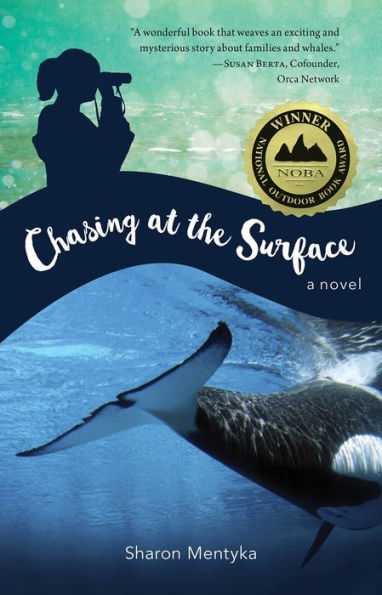Interviews
Q: What inspired you to write “Chasing at the Surface”?
As a writer, I’m interested in growing stories from small kernels of truth—items found in newspapers, bits of overheard conversations, little known historical facts. “Chasing at the Surface” is a good example. Although it’s a novel, and its characters and situations are fictional, the backstory for this book is based on a true event and much of the genealogy and science behind the study of killer whales is authentic.
The actual story goes like this. In the fall of 1997, nineteen Southern Resident killer whales (SRKW), members of L-25 sub-pod, paid an unexpected and unusual 30-day visit to Dyes Inlet, a small estuary in Puget Sound, near Seattle, Washington. Most experts believe they were following a run of chum salmon or maybe they were just curious, as killer whales can be. Either way, their 30-day visit was unforgettable.
When I decided I wanted to create a story to share the special excitement of that experience almost twenty years ago, I read all I could about the actual event, spoke to whale researchers, journalists and community residents, and visited Dyes Inlet many times. Much of what I learned became part of this book.
The story is also informed by my attempt to convey a particular sense of place—a pod of trapped orca whales in Puget Sound. The story can’t be simply uprooted and moved elsewhere. It’s not historical fiction exactly, but fiction informed by history and by what happens when you need to face situations and forces much more powerful than yourself.
Q: Are there elements of the story that relate to your own life?
Probably the most prominent personal theme of “Chasing at the Surface” is the meaning of family and discovering what it means to call a place ‘home.’ I was raised in a family where young voices were not only discouraged but often silenced, so a story about coming to recognize what is important in your own life, and learning to find the courage to fight for what you want is meaningful to me. I think that’s why I write stories for children. When I decided I wanted to write stories, I knew it would be for what I consider a very important audience because I wanted to share themes that were important to me as a child: fairness (or unfairness), transitions and helping the less powerful find their voice.
Q: What will kids relate to?
I think a lot of what is going to compel middle grade readers in “Chasing at the Surface” is the mystery of the orca whales. Why won’t they leave the inlet? What’s making them stay? How will Marisa and her friends help them get them out?
There’s just so much to learn and love about observing these highly social animals up close, and I’ve tried to bring some of these up-close experiences to life in the book. I’d be thrilled if kids found themselves wanting to learn more about orcas and orca habitat conservation after reading the book.
Q: What do adults say they like about the book?
Many adult readers enjoy the strong sense of place that the setting and the descriptions of orca habitat evokes. They also appreciate the theme of how important it is to establish a connection with nature, especially on a personal level. The vivid and accurate descriptions of the scenes with orcas have also resonated with adult readers. Other feedback includes how well the story offers a great and needed example of the importance of finding a balance between learning to trust ourselves and our intuition while at the same time being willing to ask for help when we need it—important concepts for middle grade readers.
Q: What are some of the issues and life events covered in the book that librarians could use in recommending the book?
Some key issues that “Chasing at the Surface” tackles are the genealogy and science of killer whales (Orcinus orca); wild orca and salmon habitat conservation; and how kids can take personal responsibility for protecting our environment. To a lesser degree, the book also touches on coping with parental crises, adoption and blended families—issues that that are a big part of the lives of many children today.
Q: What will educators and parents find valuable?
Today’s young readers will be faced with hard choices when they grow up as to how to keep our plant and nature’s wild species thriving. Understanding that the richness of natural diversity adds great value to our life on our planet is an important concept to learn at an early age. Discovering your own passion in life, whatever that may be, and finding the courage and faith within yourself to follow it is another valuable lesson that I have tried to impart in the book.



